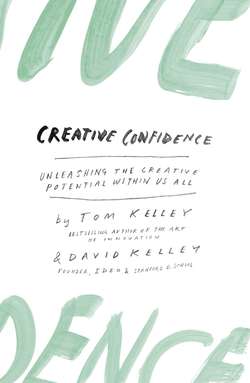Читать книгу Creative Confidence: Unleashing the Creative Potential Within Us All - David Kelley - Страница 16
NURTURING CREATIVE THINKERS
ОглавлениеWhile IDEO’s work historically focused on innovations, from the beginning the Stanford d.school has focused on innovators. Students from every graduate school at Stanford come to take classes at the d.school. It doesn’t issue degrees and doesn’t have any required courses—everyone is there because they want to be. Currently more than seven hundred students attend courses at the d.school each year. Project-based classes are team taught by faculty members from all over the university and by industry practitioners. In this diverse environment, it’s normal to hear many points of view—often conflicting ones. Students learn by doing and tackle real-world challenges, usually in multidisciplinary teams. Beyond just graduate students, executives from all over the world attend workshops, and the K-12 Lab works with children and educators (more than five hundred last year) to help spread confidence in their creative abilities.
Classes often start with simple design briefs—succinct articulations of a challenge—like “redesign the experience of getting your morning coffee.” When confronted with a question or a problem such as the morning coffee challenge, people with strong analytical skills tend to snap instantly into problem-solving mode. They leap for the finish line and then start defending their answers.
The d.school brings together ideas and people from all over the university.
(photo/illustration credit 1.3)
For example, think about how quickly a skilled doctor—when presented with a set of symptoms—makes a diagnosis and prescribes a solution. Often it’s a matter of seconds. During one morning coffee challenge a few years back, a med-school student in the class immediately raised a hand and said, “I know what we need: a new kind of coffee creamer.” For such skilled analytical thinkers, an “unresolved” issue hanging in the air is uncomfortable. They are anxious to provide an answer and move on. In routine problem-solving situations, where there is a single right answer, that method is very efficient, and sometimes quite appropriate. Creative thinkers, however, confronted with the same open-ended question, are careful not to rush to judgment. They recognize that there are many possible solutions and are willing to “go wide” first, identifying a number of possible approaches before converging on the ideas most worth implementing.
So David and the d.school professors ask the students to set aside their initial answers—the cliché ones already in their heads. They encourage students to dig deeper, to understand the situation better, observing people’s behaviors around coffee drinking in order to identify latent needs and opportunities. After the group has been guided through the design process in a collaborative environment, dozens of ideas emerge: everything from a coffeepot that knows exactly how hot you like your drink—and delivers it that way every time—to an automatic stirrer you drop into your cup. Then professors ask class members if any of the new solutions they arrived at were better than their initial ones. Usually, the answer is yes.
One prerequisite for achieving creative confidence is the belief that your innovation skills and capabilities are not set in stone.
